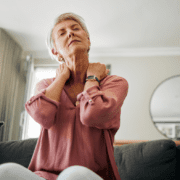5 Ways Pilates can help Manage Osteoporosis
Osteoporosis is a “silent” disease of the bones that makes them weaker and far more susceptible to breaking.
The Bone Health & Osteoporosis Foundation estimates that approximately 10 million Americans suffer from this disease, and another 44 million have low bone density. Osteoporosis affects one in two women and one in four men. A woman’s risk of breaking a bone when she has osteoporosis is equal to her combined risk of breast, uterine and ovarian cancer. For men, they are more likely to break a bone than get prostate cancer. Hip fractures are common with osteoporosis, and of the nearly 300,000 folks who fall and break their hips, 25% end up in nursing homes and never get back to their previous function.
If these statistics don’t scare you, they should. But the good news is there are plenty of things you can do – starting right now – to help protect yourself from this condition. When you research osteoporosis, diet and exercise consistently come up as key prevention strategies. When it comes to exercise, you want to make sure it focuses on healthy resistance exercises, mobility, flexibility, and balance.
Well… there happens to be one exercise system that accomplished all of this. It’s called Pilates.
Here are 5 Ways Pilates can help manage your Osteoporosis:
1. It’s a weight bearing exercise
One of the primary recommendations for preventing and managing osteoporosis is to engage in weight-bearing exercises. Well here’s the amazing thing about Pilates – the entire exercise system is based on bearing your own weight through various movements. Pilates gradually progresses you through postures of lying, kneeling, and standing – on both hands and feet – allowing you to bear weight through multiple planes and postures. This makes Pilates an excellent choice for those wanting to better manage their osteoporosis.
2. It improves muscle strength
You might be wondering… how does improving muscle strength help with bone strength? As your muscles become stronger, they pull harder on your bones, which helps improve the inherent strength of your bone. Plus, stronger muscles provide more support to your skeletal system as a whole, putting you at less risk of a fracture. Pilates in particular focuses on core strength – which is key for providing support to all your other muscles. And when you use the Pilates equipment to enhance your practice, you’ve got the resistance of springs putting special focus on all your tiny muscles, which helps strengthen areas of your body that might be inaccessible via traditional strength training methods.
3. It enhances flexibility and range of motion
It’s quite common for your joints to get stiffer and your flexibility to be impacted when you’ve got osteoporosis. You may think this is inconsequential – but stiffness and immobility can actually create more stress on your bones – which is what we’re trying to avoid. Pilates exercises emphasize the stretching and elongation of muscles, which inherently improves your range of motion. This will not only make you feel better – but makes doing everyday tasks a lot easier and they’ll feel less stressful on your body – which is important when you’re dealing with osteoporosis.
4. It encourages proper alignment and posture
Over time, osteoporosis can lead to unwanted changes in your spine, such as a stooped or kyphotic posture. Not only will these changes make it more difficult and uncomfortable to sit upright and move around, but they can make the bones (vertebrae) in these deformed areas of your spine more susceptible to damage. Pilates can help prevent and reverse these changes. Pilates emphasizes lengthened and proper spinal alignment and helps you to become more aware of your posture during the day. If you want to avoid (or even reverse) a slumped and kyphotic posture – with or without osteoporosis – Pilates can help.
5. It helps improve your balance and stability
Fall prevention is critical for those living with osteoporosis. And one of the best ways to prevent falls is to work on your balance. One might not think of Pilates as playing a key factor in this, however, Pilates is an exercise system that not only focuses on your core, but your feet as well. Everyone knows that a stronger core is going to make your whole body feel more stable. But when you’ve got feet that are more mobile and more in-tune with the ground – it dramatically improves your balance – making Pilates a safe and healthy way to not only improve your balance but decrease your risk of falling.
The best management of osteoporosis requires a multifaceted approach – and factors such as diet, nutrition, and exercise modifications must all be considered. Pilates is just one factor in the mix. But I like it because it hits on so many areas that are critical for the successful management of osteoporosis. If you’ve never tried Pilates before, I’d highly recommend giving it a whirl.
But be sure to get approval from your doctor first, and enlist the help of a movement specialist who understands how to work with someone suffering with osteoporosis.
Local to Portsmouth, NH? Consider speaking with one of my specialists by clicking HERE.
Dr. Carrie Jose, Physical Therapist and Pilates expert, owns CJ Physical Therapy & Pilates in Portsmouth and writes for Seacoast Media group. To get in touch, or enroll in her upcoming OsteoCore Strong Bones Program – visit her website www.cjphysicaltherapy.com or call 603-605-0402


